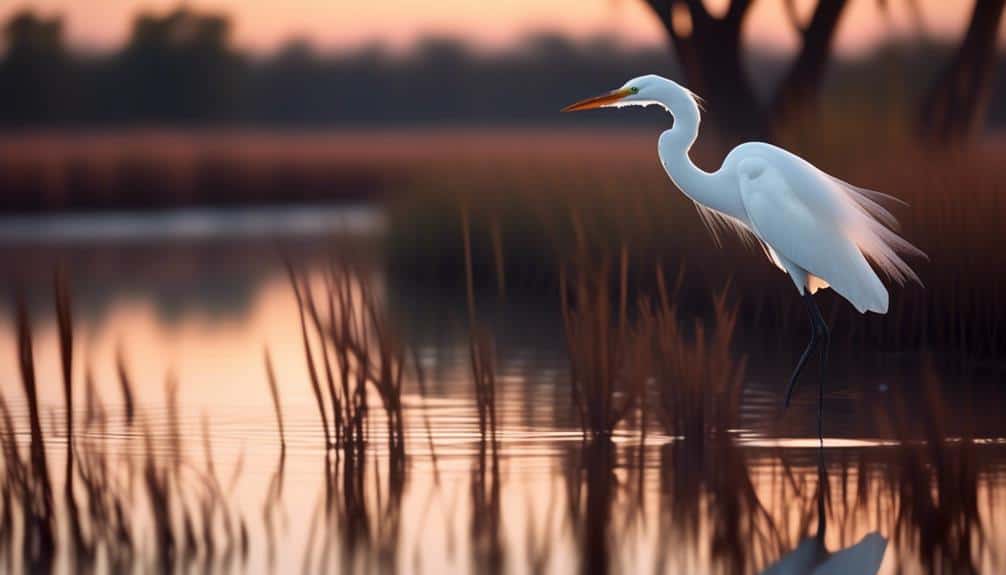As I stood on the banks of a tranquil Texas lake, my eyes were drawn to the large white birds gracefully gliding through the sky, their wings outstretched like cotton clouds floating above.
These magnificent creatures, known for their elegance and beauty, captivate both locals and visitors alike.
But what are these majestic birds that call Texas home?
Join me as we explore the world of these large white birds, their habitats, and the wonder they bring to the Lone Star State.
Great Egret: Elegant Texas Residents

As a resident of Texas, I'm fascinated by the elegant presence of the Great Egret in our state. The Great Egret, scientifically known as Ardea alba, is a large, majestic bird that's native to Texas and can be found in various wetland habitats across the state.
One of the most interesting aspects of the Great Egret is its nesting habits. These birds are colonial nesters, meaning they form large breeding colonies in specific areas. These colonies are usually located in dense vegetation near water bodies, such as marshes or lakes.
The conservation of these nesting sites is crucial for the survival of the Great Egret population. Many organizations and agencies in Texas are actively involved in egret conservation efforts, working to protect and preserve the nesting habitats of these magnificent birds. By monitoring and managing these sites, they ensure the long-term viability of the Great Egret population in Texas.
These conservation efforts play a significant role in maintaining the delicate balance of our ecosystem and safeguarding the presence of these majestic birds in our state.
Snowy Egret: A Delicate White Wonder
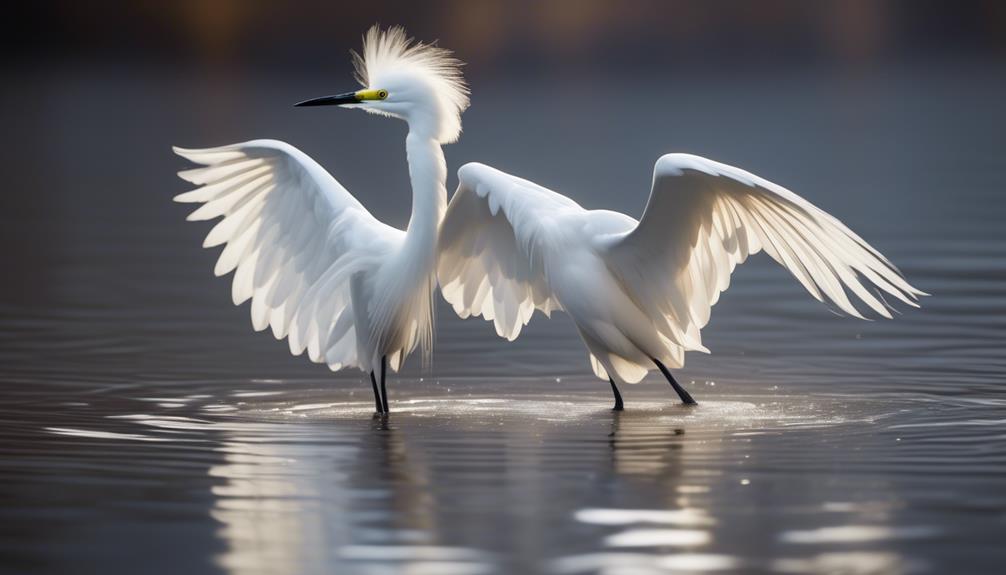
The Snowy Egret, a delicate white wonder, can be found in various wetland habitats across Texas. With its elegant plumage and graceful movements, this bird captivates both birdwatchers and nature enthusiasts alike. Here are some fascinating facts about the Snowy Egret:
- Distinctive Appearance: The Snowy Egret stands out with its snow-white feathers, contrasting sharply against its bright yellow feet and black bill. During breeding season, its plumage becomes even more striking, with long, delicate plumes flowing from its back.
- Impressive Size: While smaller than its cousin, the Great Egret, the Snowy Egret still reaches an impressive size. It typically measures about 24 inches in length, with a wingspan of around 38 inches.
- Agile Foraging: This bird is an expert hunter, using its long, slender legs to wade through shallow waters in search of prey. With quick and precise movements, it adeptly catches fish, crustaceans, insects, and small amphibians.
- Courtship Displays: During breeding season, the Snowy Egret performs elaborate courtship displays to attract a mate. These displays involve fluffing of its plumes, stretching its neck, and performing graceful dances, all accompanied by a series of calls.
Observing the Snowy Egret in its natural habitat is a true delight. Its elegant plumage and graceful movements make it a truly remarkable bird to behold.
American White Pelican: Majestic Skies of Texas

With its expansive wingspan and majestic presence, the American White Pelican graces the skies of Texas in a truly awe-inspiring manner. These magnificent birds have fascinating nesting habits in Texas and undertake impressive migration patterns.
In Texas, American White Pelicans primarily nest on islands in freshwater reservoirs, lakes, and ponds. They prefer sites that provide isolation and protection from predators. These communal nesting colonies can consist of hundreds of pairs, and the birds work together to build nests of vegetation and debris. Breeding season in Texas typically occurs from late March to early May.
During the non-breeding season, American White Pelicans migrate to coastal areas of Texas. They move from their breeding grounds in the northern United States and Canada to spend the winter in warmer climates. Texas provides an ideal stopover location for these pelicans as they make their way south. They can be seen in large flocks along the Gulf Coast, particularly in areas like Galveston and Corpus Christi.
The migration patterns of American White Pelicans are truly remarkable. They cover vast distances, flying in a V-formation, by day and night. These birds can travel over 500 miles in a single day, using thermals and updrafts to conserve energy during their long journeys.
The American White Pelican's nesting habits in Texas and its impressive migration patterns make it a captivating species to observe in the skies of the Lone Star State.
White Ibis: Coastal Beauties in Texas
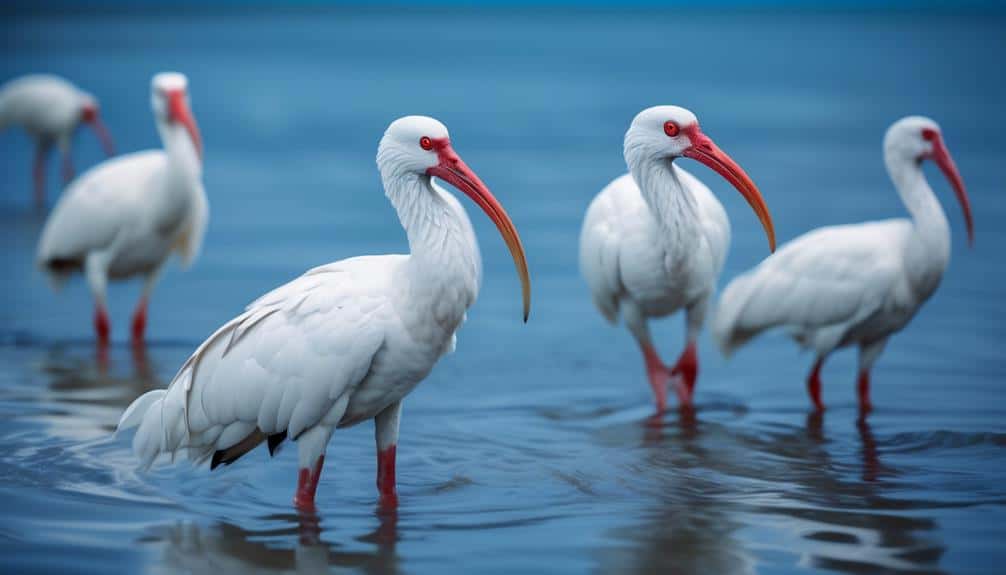
White Ibis, known for their stunning coastal presence, add beauty to the shores of Texas with their elegant plumage and graceful movements. These coastal beauties are a delight to observe and play an important role in the ecosystem.
Here are some fascinating facts about White Ibis:
- They've a distinctive white plumage, with a long curved bill and long legs. Their bright red face and legs provide a striking contrast against their white feathers.
- White Ibis are highly social birds and can be found in large flocks along the Texas coast. They're often seen foraging in marshes, mudflats, and shallow waters, using their long bills to probe for food.
- These birds are opportunistic feeders, consuming a variety of prey such as fish, crustaceans, insects, and even small reptiles. Their feeding habits make them excellent indicators of the health of coastal ecosystems.
- White Ibis also play a crucial role in coastal conservation. By dispersing seeds through their droppings, they contribute to the growth and regeneration of plant species in coastal habitats.
For birdwatching enthusiasts, the Texas coast offers excellent opportunities to observe these beautiful birds in their natural habitat. Their coastal presence not only adds to the aesthetic appeal but also serves as a reminder of the importance of conserving these unique ecosystems.
Whooping Crane: Rare and Graceful Sightings
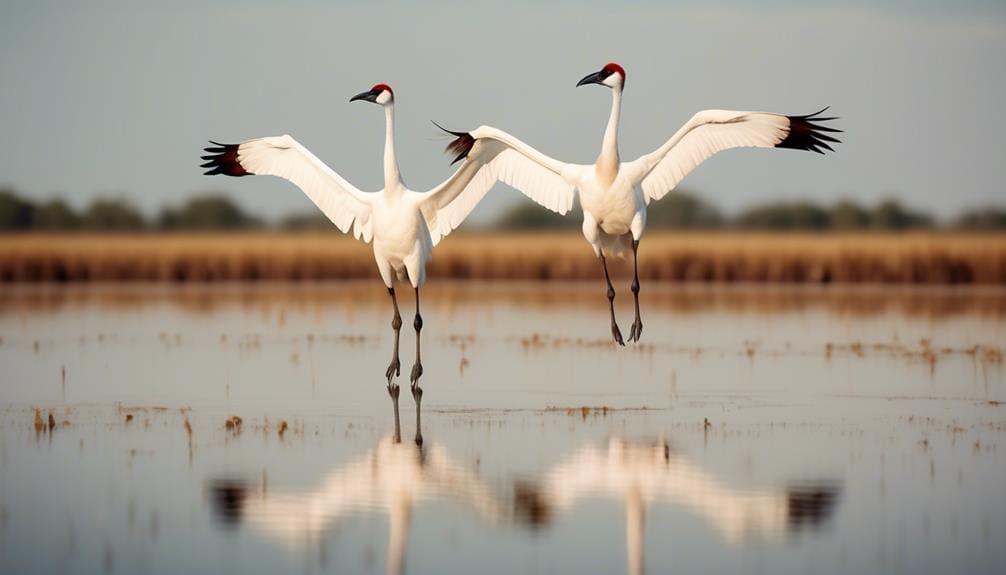
Rarely spotted in the wild, the graceful Whooping Crane is an extraordinary sight that captivates both bird enthusiasts and researchers alike. These magnificent birds are known for their distinctive appearance, with their snow-white plumage and striking red crown. Whooping cranes are highly migratory, traveling between their breeding grounds in Canada and their wintering areas along the Gulf Coast of Texas. The migration patterns of these cranes are meticulously studied to ensure the conservation of this endangered species.
Conservation efforts for whooping cranes are of utmost importance due to their small population size. With less than 800 individuals remaining in the wild, every sighting of a whooping crane is a cause for celebration. Organizations such as the International Crane Foundation and the United States Fish and Wildlife Service work tirelessly to protect these birds and their habitats.
To track the migration patterns of whooping cranes, researchers use radio telemetry and satellite tracking devices. This allows them to monitor the movements of individual birds and gain valuable insights into their behavior and habitat preferences. By understanding their migration routes, scientists can identify potential threats and implement measures to mitigate them, such as establishing protected areas and reducing human disturbances.
Observing a whooping crane in its natural habitat is an awe-inspiring experience. Their elegant dance-like displays and their resonant calls create a sense of wonder and appreciation for the beauty of the natural world. As we continue to learn more about their migration patterns and work towards their conservation, we hope to ensure that future generations can still witness the rare and graceful sightings of these majestic birds.
White-tailed Kite: Agile Hunters of Texas Skies
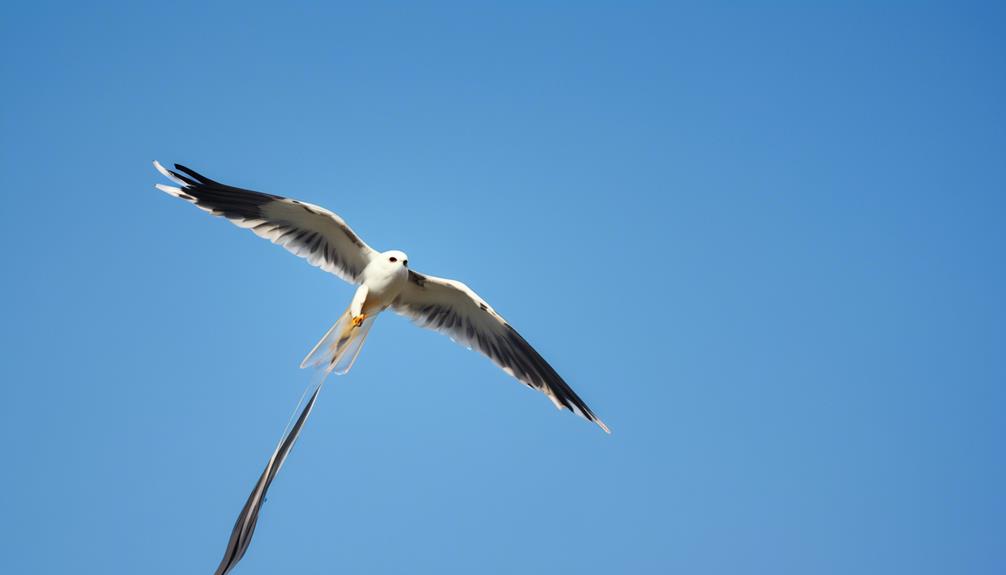
The White-tailed Kite, a skilled aerial predator, is a captivating species that can be found soaring through the skies of Texas. These agile hunters exhibit fascinating behaviors and employ unique hunting techniques that make them a remarkable sight to behold.
Here are some intriguing aspects of White-tailed Kite behavior and hunting techniques:
- Hovering: White-tailed Kites are known for their ability to hover in mid-air, flapping their wings rapidly while maintaining a stationary position. This allows them to carefully scan the ground for potential prey.
- Diving: Once the kite spots its prey, it swiftly dives down from its hovering position. With incredible precision and speed, it captures its target using its sharp talons.
- Rodent preference: White-tailed Kites primarily feed on small rodents such as mice and voles. They're highly efficient at locating and capturing these elusive creatures, thanks to their excellent eyesight and agility.
- Perching: After a successful hunt, White-tailed Kites often perch on a high vantage point, such as a tree branch or utility pole, to consume their prey. This behavior allows them to have a clear view of their surroundings, ensuring their safety while they eat.
The White-tailed Kite's remarkable hunting techniques and aerial prowess make it a true marvel of the Texas skies. Observing these agile hunters in action is a testament to their adaptability and survival skills in the wild.
Frequently Asked Questions
How Can I Attract Large White Birds to My Backyard in Texas?
To attract large white birds to my backyard in Texas, I would focus on creating a bird-friendly environment. Providing water sources, native plants, and suitable nesting spots can attract a variety of bird species, enhancing my birdwatching experience in Texas.
What Is the Average Wingspan of the Great Egret?
The great egret, a majestic bird found in Texas, boasts an impressive average wingspan. Attracting these stunning creatures to your backyard can be achieved by creating suitable heron and egret habitats.
Are Snowy Egrets Found in Other Parts of the United States?
Yes, snowy egrets are found in other parts of the United States. They can be attracted to wetlands and coastal areas, where they build nests and breed. Their breeding habits involve courtship displays and the raising of their young.
Do American White Pelicans Migrate to Texas During the Winter Months?
Yes, American white pelicans migrate to Texas during the winter months. They are attracted by the abundant food sources and favorable climate. Understanding their migration patterns helps us appreciate the grand spectacle of these majestic birds.
Are White Ibises Commonly Seen Along the Gulf Coast of Texas?
Yes, white ibises are commonly seen along the Gulf Coast of Texas. They are attracted to the region's wetlands and marshes, making it a popular birdwatching hotspot for those interested in observing these beautiful birds.
Conclusion
In the vast skies of Texas, these large white birds grace us with their presence, each one a unique wonder. From the elegant Great Egret to the delicate Snowy Egret, they paint the landscape with their ethereal beauty.
Majestic American White Pelicans soar above, while the coastal White Ibis adds a touch of grace to the shores. The rare and graceful Whooping Crane is a sight to behold, and the agile White-tailed Kite hunts with precision.
Truly, these birds are nature's masterpieces in flight.

